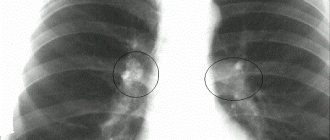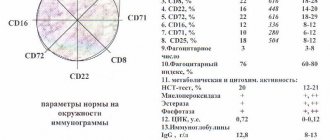Detailed description of the study
Tuberculosis is a widespread infection that is one of the world's ten leading causes of death. In 2021, 10 million people fell ill with it, of which 1 million are children, for whom tuberculosis poses the greatest danger.
The causative agent of tuberculosis, Mycobacterium tuberculosis, is a microorganism that is spread by airborne droplets from tuberculosis patients. Typically, Mycobacterium tuberculosis affects the lungs, but can also affect joints, bones, eyes, skin and even the nervous system.
The danger of Mycobacterium tuberculosis also lies in the fact that they have many mechanisms that help them evade the immune response. Mycobacterial strains that are resistant to drugs and are difficult to treat are becoming more common.
Nevertheless, according to the World Health Organization, tuberculosis can and should be treated. Most cases of the disease are treatable, and the earlier the diagnosis is made, the more successful it is.
Common symptoms of active pulmonary tuberculosis include:
- Cough with sputum and sometimes blood;
- Weakness;
- Heat;
- Unexplained weight loss;
- Chest pain;
- Increased sweating at night.
Screening diagnostic methods are the Mantoux test and fluorography, or chest x-ray. These measures allow you to suspect tuberculosis in the early stages, but have low accuracy. A microscopic examination of sputum for the presence of mycobacteria is more informative. This method detects about half of actual cases of the disease and does not provide insight into drug resistance. For accurate diagnosis, molecular biological methods are required, one of which is the assessment of antibody titer (PCR testing is also informative).
Mycobacterium tuberculosis, total antibodies
Tuberculosis is an infectious disease caused by aerobic mycobacteria (M. tuberculosis, M. bovis, M. africanus, M. microti), common in soil, water and animals. Mycobacterium tuberculosis is a type of mycobacterium that causes tuberculosis in humans in 92% of cases. M. tuberculosis is transmitted by airborne droplets from patients with active tuberculosis. In 90% of people, after a primary infection, mycobacteria settle in the lower parts of the lungs and do not lead to the development of the disease, since an immune response is developed that does not allow an increase in the number of bacteria. However, if the immune system is severely weakened, tuberculosis bacilli begin to actively multiply and tuberculosis passes from a latent form to an active one. Possible damage to the lungs, bones, joints, genitourinary organs, lymphatic system, skin, eyes and nervous system. Microscopic examination of sputum culture is still considered the gold standard for diagnosing tuberculosis. However, this method has both its advantages (high specificity) and disadvantages (low sensitivity, since a certain concentration of bacteria in the sample is required). The effectiveness of the method is lower for specific categories of people (HIV-infected people, people over 60 years of age and children who also have difficulty collecting sputum). Along with the bacteriological method, X-ray examination is widely used. Both methods are applicable only to pulmonary forms of tuberculosis. On the other hand, using the tuberculin test method it is almost impossible to differentiate latent and active forms of tuberculosis. Differential screening diagnosis of active tuberculosis is possible by determining specific antibodies to M. tuberculosis by enzyme immunoassay. At the active stage of tuberculosis, intensive production of IgG and IgM antibodies to specific antigens begins, which can be detected in the blood serum within a month from the beginning of activation of mycobacteria. High specificity of the test is achieved by using antigens specific to M. tuberculosis, which eliminates false-positive results in individuals vaccinated and infected with other mycobacteria. The sensitivity of this test system ranges from 61% (tuberculosis of the lymph nodes) to 100% (tuberculous exudative pleurisy) depending on the location of the infection, and the specificity is 95%.
References
- Chernousova, L.N., Sevastyanova, E.V., Larionova, E.E. and others. Federal clinical recommendations for the organization and conduct of microbiological and molecular genetic diagnostics of tuberculosis, 2014. - 56 p.
- Yablonsky, P.K., Vasilyeva, I.A., Ergeshov, A.E. and others. Clinical recommendations for the diagnosis and treatment of respiratory tuberculosis in adults, 2013. - 51 p.
- WHO : The Stop TB Strategy : website / WHO - 2021, - URL: https://www.who.int/tb/strategy/stop_tb_strategy/en/.National
The Ministry of Health allowed children to have a blood test instead of the Mantoux test
The Ministry of Health has provided parents with the opportunity to choose a method for diagnosing tuberculosis for their child. Among the testing options, the results of which are required to be accepted in a preschool institution, are the Mantoux test, the Diaskin test and the T-test, performed using a blood test.
This information is published on the website of the Ministry of Health. It is reported that new recommendations for testing for tuberculosis have been adopted by the All-Russian Society of Phthisiologists.
“The results of each of these tests will be considered sufficient for admission of the child to a preschool institution,”
– says the Ministry of Health.
Earlier, at a press conference dedicated to the Day against Tuberculosis, Novosibirsk experts spoke about the prevalence of this infection among children in the Novosibirsk region, and also recalled the importance of timely diagnosis.
As noted by Zhanna Shakuro, head of the children's department of the branch of the State Budgetary Healthcare Institution NSO NOPTD "Anti-tuberculosis dispensary No. 6", the incidence of tuberculosis among children in the Novosibirsk region is decreasing, although not at such a rapid pace as among the adult population.
According to her, the bulk of the sick are children of preschool age. However, only about 13% of patients are children from disadvantaged families.
“To date, we have no relapses after treatment in children and adolescents. And the earlier the tuberculosis process is detected at an early stage, the more effective its treatment and the more favorable the prognosis for this patient.”
, - said the expert.
Tatyana Kolpakova, head of the clinical department of the Federal State Budgetary Institution "Novosibirsk Research Institute of Tuberculosis" of the Russian Ministry of Health, recalled that, according to current legislation, every child upon admission to school or a preschool institution must be examined for tuberculosis. The main diagnostic method remains tuberculin diagnostics (or Mantoux test), Diaskintest, computed tomography and x-ray examination are used as additional methods.
The Mantoux test is performed on children under 18 years of age, and Diaskintest on adolescents from 15 to 18 years of age. At the same time, Tatyana Kolpakova clarified that these are not interchangeable techniques: the main diagnostic method remains the Mantoux reaction, other procedures can be performed as additional ones.
The expert also added that there are no absolute contraindications against the Mantoux reaction.
“Now a problem is emerging when specialized specialists prescribe a medical exemption from tuberculin diagnostics, which is currently illegal, they violate the legislation of the Russian Federation”
, she warned.
However, the child’s parents have the right to refuse tuberculin diagnostics, and in this case, X-rays become the most reliable alternative.
“But an X-ray examination already shows the tuberculosis process itself in the child’s body; we cannot see the moment when the child is infected, that is, when tuberculosis bacteria entered him from the outside.”
,” explained Tatyana Kolpakova.
According to her, the advantage of the Mantoux reaction is that this method allows you to track infection and prescribe preventive treatment that will prevent the development of the tuberculosis process.
“Parents often tell us: “I know that my child is healthy.” But knowing does not mean being healthy. To really know that your child is healthy, you need to undergo an examination,”
– the specialist reminded.
After the press conference, information appeared about the expansion of tuberculosis diagnostic methods through the T-test (T-SPOT), performed using a blood test. The proposal to give parents a choice in this matter was initiated by the Commissioner for Children's Rights under the President of the Russian Federation, Anna Kuznetsova.
Mycobacterium tuberculosis, antibodies
Antibodies to the causative agent of tuberculosis ( M. tuberculosis) are specific immunoglobulins produced by the immune system in response to infection with the causative agent of tuberculosis.
General information about the study
Tuberculosis is an infectious disease caused by aerobic mycobacteria (M. tuberculosis, M. bovis, M. africanus, M. microti), common in soil, water and animals. Mycobacterium tuberculosis is a species of mycobacterium that causes tuberculosis in humans in 92% of cases.
M. tuberculosis is transmitted by airborne droplets from patients with active tuberculosis. In 90% of people, after a primary infection, mycobacteria settle in the lower parts of the lungs and do not lead to the development of the disease, since an immune response is developed that does not allow an increase in the number of bacteria. However, if the immune system is severely weakened, tuberculosis bacilli begin to actively multiply and tuberculosis passes from a latent form to an active one. Possible damage to the lungs, bones, joints, genitourinary organs, lymphatic system, skin, eyes and nervous system.
Microscopic examination of sputum culture is still considered the gold standard for diagnosing tuberculosis. However, this method has both its advantages (high specificity) and disadvantages (low sensitivity, since a certain concentration of bacteria in the sample is required). The effectiveness of the method is lower for specific categories of people (HIV-infected people, people over 60 years of age and children who also have difficulty collecting sputum). In addition, this study takes a long time, since bacteria require 6-8 weeks to grow. Along with the bacteriological method, X-ray examination is widely used. Both methods are applicable only to pulmonary forms of tuberculosis. On the other hand, using the tuberculin test method it is almost impossible to differentiate latent and active forms of tuberculosis.
Differential screening diagnosis of active tuberculosis is possible by determining specific antibodies to M. tuberculosis by enzyme immunoassay.
At the active stage of tuberculosis, intensive production of IgG and IgM antibodies to specific antigens begins, which can be detected in the blood serum within a month from the beginning of activation of mycobacteria. Among antibodies in tuberculosis in adults, IgG usually predominates; less often, the overwhelming number of antibodies is represented by IgA. IgM antibodies in adults are quite rare and are more typical for the initial stages of the disease. In children, high titers of specific IgA and IgM are observed much more often, and high levels of IgM can sometimes persist even with a long history of the disease and relatively low levels of IgG and IgA antibodies. In general, the picture of the antibody response to tuberculosis is very individual, complex and depends on a large number of factors. This test allows you to identify the total pool of antibodies specific to mycobacterial antigens, which makes it possible to cover the widest possible range of variants of the humoral response to tuberculosis. High specificity of the test is achieved by using antigens specific to M. tuberculosis, which eliminates false-positive results in individuals vaccinated and infected with other mycobacteria. The sensitivity of this test system ranges from 61% (tuberculosis of the lymph nodes) to 100% (tuberculous exudative pleurisy) depending on the location of the infection; specificity – 95%.
What is the research used for?
- To detect active tuberculosis, especially extrapulmonary forms.
- To monitor the effectiveness of tuberculosis treatment.
- To identify infected individuals.
- To confirm the diagnosis (along with the use of additional diagnostic tests).
When is the study scheduled?
- When it is known that the patient has had long-term contact with tuberculosis patients or that his work involves constant contact with people at risk (homeless people, injection drug users, people in prison).
- For appropriate symptoms: weakness, fatigue, low-grade body temperature, night sweats, persistent cough for 2-3 weeks, chest pain (pulmonary tuberculosis), chronic pain in the back, joints, abdominal area with unknown etiology.
- For long-term unsuccessful treatment of chronic prostatitis, cystitis, pyelonephritis and inflammation of the endometrium (tuberculosis of the genitourinary organs).
For anemia, leukocytosis.







